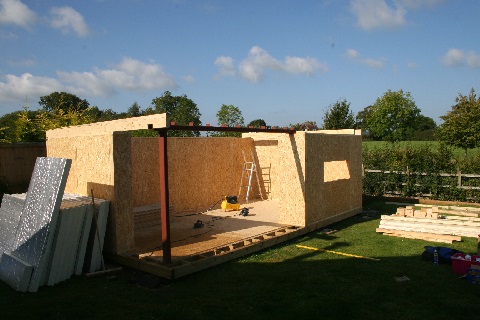U Values Explained
U Values
U values are how we measure and compare the insulation performance of materials and combinations of materials. These figures are defined from laboratory tests carried out by the insulation manufacturers and then published and tell us how effective elements of a building are as insulators.
Knowing the U values of a range of different types of insulation materials, helps us to rank and assess material at a given thickness in an order of good to bad insulators. When it comes to an insulated garden room we want good insulating materials in our floor, walls and roof structures and in our glazing. A good insulating material will have a low value and a bad insulating material will than high value.
It is worth noting that U values change for each material when you change the thickness of that material, so a 100mm piece of polyurethane insulation will have a different U value to a 120mm piece of polyurethane insulation. That is why when you compare materials against each other, it is important to understand the thickness, doubling the thickness halves the U value increasing the buildings energy efficiency performance.
Also worth noting is than most materials have a U value and contribute someway as an insulator, it is just some are better than other. As an example, looking at a garden room wall structure which is a combination of many materials, the external cladding, exterior sheeting, internal plasterboard and the insulation layer, all of the individual layers will contribute to the overall U value of the wall as a structure, it is just that all the different layers contributions will be small when compared to the contribution from the insulation layer.
Here are our calculated overall U values
Floor: 0.19 W/m^2K
Walls: 0.18 W/m^2K
Roof: 0.17 W/m^2K
Glazing: 1.9W/m^2K
Quoting a figures like these doesn’t really provide much information, it needs some context either via comparison to another material or by comparison to a recommended standard, for this we have the Part L building regulations which we can use as a guide. Remember lower is better so you want to be matching or under these numbers.
Part L build regulation requirements
Floor: 0.25 W/m^2K
Walls: 0.30 W/m^2K
Roof: 0.20 W/m^2K
Glazing: 2.00 W/m^2K
Although there is no legal requirement for a garden room to meet these guidelines, you can appreciate that if a buildings U values are far from what is recommended for a new home, then it won’t perform well as usable space all year around. If a garden room exceeds (lower value) or matches the recommendations, you can appreciate that this would provide a usable space all year around with reasonable ongoing energy costs.
You can see from the numbers that in every area our build specification provides U values lower than the recommended levels. This is how we provide you with the confidence that your new insulated garden room will be usable 365 days a year.
Additional Resources
For more information on U values see Wikipedia, here.
More Information
DETAILS THAT MAKE OUR INSULATED GARDEN ROOMS CLASS LEADING
Insulated garden rooms
There are many insulated garden rooms available on the market, but it is the type of insulation and the thickness of the insulation used that matters. As we offer class leading levels of thermal insulation, we can comfortably discuss and disclose our insulated building specifications. Knowing this will provide you with the confidence needed that you new garden room will be usable 365 days a year.
Types of insulation
Insulation roll, insulation board, fiberglass insulation, Celotex, Kingspan! The topic of insulation materials and the types of insulation available, can sometimes leave a level of confusion, which material is best and what thickness do I need? If you have every wandered down the insulation aisle at b&q or wicks, glaring at the 4 x 8 sheets and shrink-wrapped rolls, you will know what I mean. Here we discuss the different types of insulation used by most garden room suppliers and the pros and cos of each. Remember, not all insulation is equal.
Energy efficiency
In most cases insulation type and thickness are key factors to consider when choosing a garden room supplier, as these factors contribute to the overall energy efficiency performance of the garden building. With many different material types, claims on energy efficiency performance and the possibly confusing world of u-values, we decided to return to one of our completed garden rooms, to find out how one of our previous builds performs in a real word environment.
Build specification
We sometimes hear comments comparing a modern insulated garden room to no more than an insulated garden shed, for our insulated garden buildings that really isn’t the case. We don’t supply the cheap garden rooms that you can find made from shed like materials, instead we use residential specification materials that you would find in the build specification of any newly build home. This includes the insulation, main structure, windows and doors, roof weather proofing and external cladding among others. This results in quality buildings, that have a solid feel and will undoubtedly last the test of time. This approach does mean we are not the cheapest garden building supplier, however we do offer the most value.





